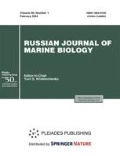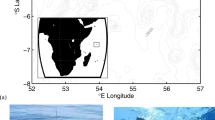Abstract
An autonomous system of remote audio and video surveillance of marine mammal activity has been designed and installed in the Far Eastern Marine Biosphere Nature Reserve (Peter the Great Bay, Sea of Japan) for monitoring the condition of the spotted seal (Phoca largha Pallas, 1811) population in the reproductive zone. This system makes it possible to collect information on animals without affecting their natural behavior.

Similar content being viewed by others
REFERENCES
Burdin, A.M., Lisitsina, T.Yu., Burkanov, V.N., et al., Application of remote video system for biological research on Steller sea lion (Eumetopias jubatus) at cape Kozlova (Kronotskiy State Nature Reserve, Kamchatka), in Tezisy dokladov Vtoroi Mezhdunarodnoi konferentsii “Morskiye mlekopitayushchiye Golarktiki” (Baikal, Rossiya, 10–15 sentyabrya 2002 g.) (Proc. 2nd Int. Conf. “Marine Mammals of the Holarctic”, Baikal, Russia, September 10–15, 2002), Moscow: KMK, 2002, pp. 53–54.
Katin, I.O., The Spotted Seal of Peter the Great Bay, Sea of Japan (characteristics and use of haulout sites, population status), Cand. Sci. (Biol.) Dissertation, Vladivostok: Inst. Biol. Soil Sci., Far East. Branch, Russ. Acad. Sci., 2006.
Katin, I.O. and Nesterenko, V.A., Oceanological conditions and reproduction of the spotted seal (Phoca largha) in Peter the Great Bay of the Sea of Japan, Oceanology (Engl. Transl.), 2010, vol. 50, no. 1, pp. 77–82.
Nesterenko, V.A. and Katin, I.O., Haulout: Scope of the term and procedure for identification, Russ. J. Ecol., 2009, vol. 40, no. 1, pp. 48–54.
Nesterenko, V.A. and Katin, I.O., Larga (Phoca largha) v zalive Petra Velikogo (Spotted Seal (Phoca largha) in Peter the Great Bay), Vladivostok: Dal’nauka, 2014.
Usatov, I.A., Altukhov, A.V., and Burkanov, V.N., Seasonal dynamics of the number of Steller sea lions at the reproductive rookery at Cape Kozlov, Kamchatka, in Materialy XV nauchnoi konferentsii “Sokhraneniye bioraznoobraziya Kamchatki i prilegayushchikh morei” (Proc. XV Sci. Conf. “Conservation of the Biodiversity of Kamchatka and the Adjacent Seas”), Petropavlovsk-Kamchatsky: Kamchatpress, 2014, pp. 372–376.
Boveng, P.L., Bengtson, J.L., Buckley, T.W., et al., Status Review of the Spotted Seal (Phoca largha), NOAA Technical Memorandum, no. NMFS-AFSC-200, Washington, DC: U.S. Dep. of Commerce, 2009.
Burdin, A.M., Hennen, D.R., Calkins, D.G., et al., Can we see a cohort effect on survival of Steller sea lions (Eumetopias jubatus) at Kozlova Cape rookery (eastern Kamchatka, Russia)?, Mar. Mamm. Sci., 2009, vol. 25, no. 4, pp. 888–901.
Maniscalco, J., Atkinson, S., and Armato, P., Early maternal care and pup survival in Steller sea lions: a remote video monitoring project in the Northern Gulf of Alaska, Arct. Res. U. S., 2002, vol. 16, pp. 36–41.
O’Corry-Crowe, G., Lowry, L.F., Burkanov, V.N., et al., The biogeography and population structure of spotted seals (Phoca largha) using mitochondrial DNA, in 14th Biennial Conf. Biology Mar. Mamm., Vancouver, Canada, November 28–December 3, 2001, p. 159.
Shaughnessy, P.D. and Fay, F.H., A review of the taxonomy and nomenclature of North Pacific harbour seals, J. Zool., 1977, vol. 182, pp. 385–419.
ACKNOWLEDGMENTS
We are grateful to all who participated in the implementation of the idea to use remote surveillance for monitoring the condition of the spotted seal reproductive grouping. Special thanks are due to the administration of the Far Eastern Marine Biosphere State Nature Reserve, its Director N.A. Yakushevsky, inspector S.G. Minov, and also to OOO Kordon-Inform and its Director N.M. Getman.
Author information
Authors and Affiliations
Corresponding author
Ethics declarations
Conflict of interests. The authors declare that they have no conflict of interest.
Statement on the welfare of animals. All applicable international, national, and/or institutional guidelines for the care and use of animals were followed.
Additional information
Translated by E. Shvetsov
Rights and permissions
About this article
Cite this article
Katin, I.O., Nesterenko, V.A. The Use of a Remote Surveillance System for Monitoring the Reproductive Grouping of the Spotted Seal (Phoca largha Pallas, 1811) in Peter the Great Bay, Sea of Japan. Russ J Mar Biol 47, 64–67 (2021). https://doi.org/10.1134/S1063074021010041
Received:
Revised:
Accepted:
Published:
Issue Date:
DOI: https://doi.org/10.1134/S1063074021010041




